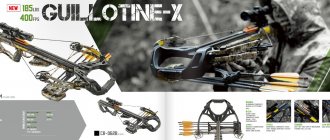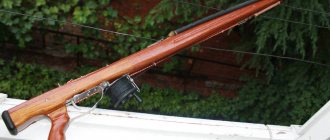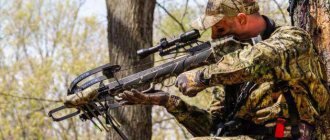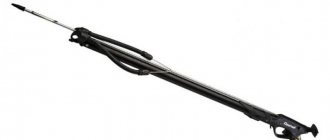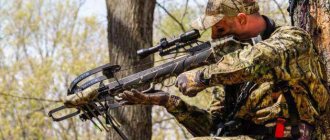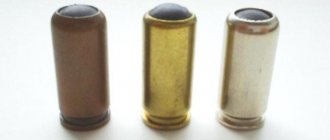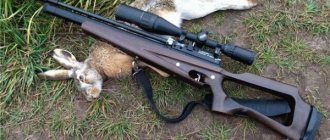Hunting with a bow or crossbow in modern Russian realities is much less common than with a gun. The first reason is the high cost of equipment, and the second is the need to master the theoretical and practical parts of using throwing weapons.
The choice between a crossbow or a bow will depend on the skills of the shooter and his personal preferences in hunting, which is better suited for a particular type of hunting. Many hunting enthusiasts strive to at least try these types of weapons, because it is reliably known about the unforgettable sensations obtained in the process.
Features of hunting with a bow and crossbow
The ability to shoot a firearm does not provide any significant skills in handling a crossbow or bow. Which one is best for each hunter, he must decide for himself. Mastering archery is not as difficult as you might think at first glance. However, good skill in handling a bow is achieved by practicing aimed shooting and attending instructions from masters.
However, it is somewhat easier to switch to crossbow shooting for those who have previously had experience using firearms. Good shooting with a gun will allow you to quickly get used to targeted shooting with crossbow arrows and not feel much discomfort from changing uniforms. If the shooter has no experience at all in shooting from a throwing weapon, the game has a better chance of survival in case of an unsuccessful but traumatic hit from a bow, whether it is better to use a bow or a crossbow in this case, from the point of view of humanity, should be taken into account.
In fact, hunting of this kind bears little resemblance to an entertainment event; it is rather an art and the work of real hunters. In addition, hunting with a bow or crossbow is a real sports discipline, no less significant than similar sports involving shooting with firearms.
A soulless crossbow versus a noble bow. Reality and legends
“Tsangra” is a type of early medieval crossbow, the specific features of which will be discussed below. But Yutanov’s “crossbow” is something else. That is, judging only by this quote, it could also be a crossbow (in Rus' this weapon was called that), but other descriptions suggest that they meant something like an underwater - in this case surface - gun with spring mechanism. And even multi-shot (Yutanov firmly vouches for the possibility of two shots in a row).
We’ll talk about such crossbows even more below. Well, at least because earthly reality did not know them (and was deeply right in this ignorance). For now - about crossbows. In the form they are familiar to the average reader (or viewer).
In historical novels and films, the attitude towards crossbows is ambiguous. Some authors (directors too) strive to very demonstratively separate the glorious old “world of high martial art” from the “world of machines” - and as a result, the crossbow turns out to be classified precisely in the machine world. This is quite enough to see in a crossbow not a bow with a mechanism for tension and release, but a “dishonest” weapon of a mechanical overkill. It looks especially good in the enemy's clutches: it is hardly by chance that during the Hollywood assault on Helm's Deep, crossbows were fired exclusively by Urukhai - who, in addition, are themselves the product of ominous technical experiments. In this situation, the crossbowmen, of course, are simply bound to lose to the archers in the end. Which they do with success.
The loader has a block gate, the loader already has a tension hook hanging on his belt, which he apparently used. The brigandines and helmets of both crossbowmen are so pretentious that they could even be considered science fiction right now; but this is not the fault of medieval gunsmiths, but of the medieval artist
And then there are computer games, which in recent years have had a very significant influence, if not on literature in general, then on the “weapon” ideas of writers (and, again, filmmakers). They are full of crossbows, but a crossbow is a clumsy weapon, slow, low-kill and rarely used (all negative comparisons!). The crossbows in Diablo II are especially impressive, divided into “light” (certainly copied from fairly heavy combat crossbows of the 14th-15th century) and “heavy” (these are copied more accurately - but from what?! From the “shot” crossbows of the 16th-15th century) XVII centuries, the lightest, used for hunting birds and four-legged creatures like hares!). Their capabilities there are frighteningly low - just like bows; Perhaps this is a constant feature of all games, whose field is inevitably limited by screen space, which allows you to shoot at a target at a few tens of steps, but not at many hundreds. As a result, the monsters manage to slip past the affected area before another arrow falls from your aunt, and all the advantages of ranged combat come to naught...
But is the crossbow really a weapon of technical civilization (albeit in its early stages), a kind of brainchild of soulless mechanical progress, displacing and replacing the noble bow along with the no less noble sword?
Of course, reality is more complicated than legends. Let's start with the fact that there are no more mechanics in crossbows (at least early ones) than in a spinning wheel. And they appear not as weapons of medieval cities, but much earlier.
The purpose of the first crossbows was to give an unimportant shooter a chance to make at least a minimally decent shot. Moreover, this shooter is not necessarily a warrior. In the ancient Mediterranean, crossbow-like weapons appeared for the first time, perhaps, among hunters. In the military environment, it became quite well known already by the 4th century: in fact, it was through the late Roman army that the name “arcballista” (bow-ballista), i.e. crossbow, spread...
The Romans were very unimportant shooters: both in hunting and in military forms. Therefore, such a help to the traditional bow and sling came in very handy for them. However, like the ancient Chinese, among whom the crossbow spread a very long time ago, long before the beginning of our era - and also became a military weapon much earlier than in the Mediterranean. However, the earliest ancient crossbows are no younger than the Chinese ones - but the big question is whether they are the direct ancestors of the archballists of Roman times. The fact is that the ancient Greek gastraphetus, according to its principle of action, is undoubtedly a crossbow; in size and weight too. However, it does not appear as a hand-held small weapon, but as a siege machine, an early and light type of easel ballista. And the descendants of Gastraphetes, apparently, were not used for hand-held shooting: neither in hunting, nor in field battles.
So, crossbows emerge as weapons of “bad shooters.” Let us say right away that the absence of good archers in any civilization may be an indicator of a sedentary agricultural bias, but in no way a criterion of technical progress. The same Romans emerged as terrible archers long before they learned to build megacities...
Yes, among the urban population of medieval Europe the proportion of “bad shooters” is increasing. But by that time, the crossbow was gaining wide popularity among very good shooters, military masters, professionals who valued the quality of the shot much more than the number of shots per unit of time. And since the level of mechanization has seriously increased, the trigger and especially tensioning mechanisms of crossbows become the “brand name” of the developed Middle Ages.
Actually, contrary to anti-technical legends, the rate of fire of crossbows is not so low. Even those that are tensioned with block gates and - especially! - rack and pinion transmission, allowing for three aimed shots per minute. This is if both the crossbow is strong and the shooter is strong (yes, we are not talking about skill, but about physical strength that allows you to quickly rotate the handle of the tension gate). If only the first one is strong, well, one shot every thirty seconds is also guaranteed.
What is “strong” in relation to a crossbow? Well, if we are talking about those types that are equipped with the most advanced tensioning mechanisms (this is the same rack and pinion gear, a ratchet operating on the principle of a jack), then 250-300 kg is a fairly ordinary force of a powerful arc. 400 kg is a lot of force, even for powerful crossbows: here we are most often talking about heavy weapons that fire from a support, although not truly easel ones. But they can also shoot from such a crossbow from the hands, moreover, the MOST powerful of the “hand” crossbows had a force of about 600 kg! Of course, only the heaviest guys could shoot from them: no one canceled the laws of physics, the recoil was fierce, like an “elephant-killer” gun or even an anti-tank gun (light, of course). So even for such a guy, at the slightest opportunity, it would be better to rest his stock on a fortress wall, on the edge of a siege shield replacing a bipod, on a fallen tree, etc., etc. However, we are still talking about hand weapons, and not throwing machines.
It's interesting what their triggers looked like. Do you think the trigger should have been pressed with the usual, natural and seemingly only possible movement of the index finger? Sometimes - in this very way, but its “naturalness” was not obvious for a long time. In the earliest crossbows, it seems that the trigger mechanism was released with almost the entire hand, in a motion similar to the movement of a rifle bolt. Subsequently, crossbows had a trigger lever (not a hook!), which had to be pressed in much the same way as pressing a handbrake mounted on the handlebars of a bicycle. In different crossbows, different arrows did this with a movement not back, but back-and-up, or even just up: with the index finger, the index and middle fingers together, the thumb (!), the little finger (!!)…
And this is rack and pinion tension. The arrow, as we see, in this case is not feathered
And earthly crossbows received a stock with a well-defined shoulder rest quite late, under the influence of... muskets. Before that, crossbowmen had a different anatomy, or what?!
But seriously, tensioners were even more different than triggers. For relatively weak crossbows, certain types of levers were used, mostly overhead ones. Actually, the combat versions of these devices were always not made integral with the weapon itself; they were disconnected before firing; Only in modern sports, hunting and sabotage models are “integral” levers and pulley strings with eccentric wheels attached to the end of the arcs adopted. These modern models are designed for measly tens of kilograms: without mechanisms, a modern shooter cannot handle such tension (shame!!!). Such pulleys with wheels in the spirit of "Rambo 2" - however, there was a bow (double shame!!!) - make it easy and quick to pull the bowstring, but reduce accuracy. The most powerful of the medieval levers are capable of cocking a 200-250-kilogram - not by weight, of course - arc, and noticeably faster than a gate, although they themselves require the application of greater force.
There was also a belt hook (the belt, of course, is also special: part of the weapon!), sometimes with a cable and a small block attached to it, which, in turn, was attached to the crossbow before pulling the bowstring. In other cases, they did without a block: the hook was placed on the bowstring and forcefully straightened from a half-bent position. A crossbow bow with a power of 100-150 kg could be pulled in a few seconds.
Weapons of such power were sometimes drawn without any equipment at all - however, with great training and with a serious expenditure of one’s own strength. Place your foot (and sometimes both feet) in the crossbow stirrup (in primitive crossbows, on the bow itself), grab the bowstring with both hands, and straighten until the bowstring is hooked. This is how those same tangs are made for shooting.
If you move not from a half-bent position to a standing position, but from a half-sitting position to a lying one, then you can squeeze out 300 kg. However, this will not give much gain in speed, but it will require free space - which is not always convenient in formation. In general, this is rather a Chinese style, and Chinese crossbows are very unique, we will also talk about them later.
With such a powerful weapon, what is the effective firing distance?
So you won’t answer right away. It depends on what, for whom and for what purpose.
Let’s make a reservation right away: according to their intended purpose, crossbows can be long-range and armor-piercing. The first ones are needed to fire the first salvo from the maximum possible distance at the Genghis Khan-like horde rushing towards you, and then have time to repeat such salvoes as many times as possible before the enemy gets to the archery shot. This is precisely the classical Chinese tradition of field battle. Strictly speaking, it did not work against the Mongols of the era of Genghis Khan, but nothing and no one worked against them - the point here is not the weapon as such.
The arrows of the crossbows of this school (yes, we are again talking about the school of combat, and not about the weapon itself) are almost archery. They are relatively light, cannot penetrate serious armor, and fly far. In principle, we can overcome the kilometer limit for them, but they still prefer to fire a well-coordinated salvo, even the first, from a distance of no more than 700 m.
Crossbows of the European tradition are rather armor-piercing. They have another super task: to be guaranteed to defeat a well-armored enemy at not necessarily the maximum distance.
The weight of the ammunition is frightening: 160 g is a fairly ordinary arrow, but even 400 g is by no means the maximum. The maximum is under 800, but this is already for those crossbows that are on the verge of becoming easel ones. Quite often the arrow is devoid of feathers, but the balance and configuration of the shaft are designed so that it does not tumble in flight.
It is clear that it makes sense to consider long-range shots only for the lightest varieties of these arrows: 65-100 g. They are still much more massive than the arrows of a combat bow, especially those thin, almost fragile samples that archers fired at long distances. Well, the entire range of such a crossbow arrow is 600 meters, and at 450 m even just a good shooter (and not wonderful on the verge of phenomenality, as in the case of a bow) confidently hits a person, piercing his chain mail, leather armor, a light shield - in a word, something that is invulnerable to a long-range arrow. At the same time, the weight of the combat crossbow itself usually fluctuated between 4-8.5 kg: not at all prohibitive compared to the weight of an arquebus, rifles from the era of both world wars, and, by the way, truly powerful combat bows.
So the ephemeral nature of the “advantage” of even the strongest archers over crossbowmen at long range is completely obvious. Another thing is that in the field battles of the Hundred Years' War, the British often exchanged fire with crossbowmen at two or three hundred meters, “hammering” them with their rate of fire and large ammunition (how many 160-gram arrows can you take with you?). But this is already from the extensive list of examples of moronic command regularly displayed by the French side. But during the defense (or assault) of fortresses, even this command could not force the crossbow to yield to the bow!
A crossbow arrow is traditionally called a “bolt”, and not only in English-language literature (although, for example, in German weapons science this name has not yet replaced the traditional form of “bolts”). To everything that has been said about the difference between a bolt and an archery arrow, let’s add this: a bolt, as a rule, is standardized, it is one of the first items of mass production, thousands of maximally identical ready-made arrows, standard tips, measured and hung blanks for shafts are collected in arsenal storage facilities... Archers also highly value the uniformity of their ammunition, but if for modern athletes this is just a light in the window, then for archers-warriors of the old school a slightly different approach was characteristic. Yes, all their arrows must be suitable for their bow, that is, almost standard, but at the same time, the shooter “recognizes” each of them by sight, as well as by name and voice! He knows exactly what to expect from her, at what distance, in what wind and humidity... Some of the fantastic achievements of such archers are based precisely on such knowledge! For salvo shooting at the limit of destruction, when special accuracy still cannot be achieved, - arrows from spare cases, “shirpotrebovskie”, carried in convoy carts; and when the enemy approached - our own, acquaintances...
So in this sense, the crossbow is, of course, more unified and less dependent on the personal characteristics of the shooter. The musket continued this trend, and the rifle with a unitary cartridge completed it...
By the way, so that there are no illusions about armor-piercing: a knight in highly developed armor of the 15th century. - a very difficult target even for a shooter with a powerful infantry crossbow. If you really hit “along the contour”, without choosing vulnerable spots, then a hundred meters is indeed almost the maximum limit for penetrating a cuirass. Another thing is that a master crossbowman can choose vulnerable spots: no worse than a master archer, and even better than a musketeer (whose effective shooting distance is much lower!). But an ordinary crossbowman, when repelling a mounted attack, will have time to fire only one guaranteed dangerous shot, and before that another long-range shot, of dubious lethality - well, even less dubious than that of a bow. So questions about field fortifications and interaction with other branches of the military are extremely relevant for crossbowmen. In the case of competent command (this also happened), they were successfully resolved - and then the crossbow really became one of the trump cards of victory.
A crossbow in equestrian combat had not so small possible
Excuse me, but what does “infantry crossbow” mean: was there even a cavalry crossbow? Yes, sure. The back ranks of the knight's “spear” were made up of mounted crossbowmen (need I explain that in this case it is not a weapon, but a unit, a “combat unit”?): the front ranks consisted of mounted men-at-arms. When approaching a similar “spear” of the enemy, the crossbowmen managed to fire a long-range volley along a suspended trajectory (arrows falling in a steep arc are especially dangerous for enemy horses, which, even in the era of armor, were rarely covered entirely with armor: the croup was usually left unprotected), and then... Then they had enough time to reload the weapon - more often with the help of a “goat leg” than a slatted gate - and fire the next shot at point-blank range, just when the spearmen of the first line of both “spears” collided at a gallop. It is clear that they did not shoot at the back of their knights, but at the gaps between them or at the chest of one of the enemies who, having knocked the “sparring partner” out of the saddle, broke through the line.
The third time it was impossible to reload the weapon in such a battle: I had to grab the sword, and “take the crossbow on a belt” behind my back, fend off the enemy’s spear with it - yes, there was such a technique, even just throwing it. But the first two shots (especially the second!) completely paid for this tactic. We won’t argue with those who say that this is where a cavalry bow is more applicable, even with less armor-piercing power: maybe more, but there are no skills, and you can’t acquire them that easily, they drag along the basic attributes of civilization. However, in the deadly moments before the second shot, the mounted crossbowmen showed the highest class of stunt special effects - sometimes they even shot back over the shoulder if the enemy managed to maneuver (not a trick or a hyperbole - but a technique from one textbook of the military art of the 15th century)!
By the way, keep in mind: crossbows for mounted combat are, on average, weaker than infantry ones - but shooting at a gallop significantly increases the energy of the arrow strike (of course, not accuracy; and, equally of course, when shooting forward, and not over the shoulder). The total convergence speed of riders flying towards each other is about 30 m/s, even on a real battlefield, and not a specially equipped lists. This is only half the speed of ejecting a light arrow from a very powerful crossbow. Consequently, it will hit one and a half times harder than when shooting from a standstill. Not bad!
The material of the crossbow bow is not only steel. Wood, bone, and horn pads were used. In the East - bamboo. Let's take into account: elastically forged weapon steel fights the cold ineptly - during really serious frosts, both damask swords and... crossbow bows become brittle! That is why even in medieval Europe (yes, yes, not the Siberian climate!) “winter” crossbows were made of wood and horn plates.
Rubber did not coincide with combat crossbows in space-time. What if? After all, there are “rubber crossbows” - one of the categories of underwater guns!
The crossbow, admittedly, is not completely silent when fired. And some of its types have something like a barrel (with side slots for a bowstring), although this is more of a hunting than a combat exotic. And it can be amazingly compact. The smallest “ballestrino”, bullet crossbows from the 16th century. — the size of a lady’s pistol: you can hide them in your pocket, and even put them in a standard-sized book! Moreover, crossbows are relatively powerful, with a “built-in” ratchet! At the distance of a sword thrust, such a bullet can kill if it hits the eye or temple (just like a bullet from a ladies’ pistol). I would say that the sword is more reliable, but I won’t say: what does reliability have to do with it, because such a ballestrino was not intended for self-defense or terrorism, but for training shooting at small birds and indoor targets.
If the Terminator did not have a pump-action shotgun at his disposal, a Chinese repeating crossbow with a “clip” of ten arrows (and in a double version, twenty arrows fired in the same ten shots!) would be very useful to him!
Repeating crossbows are also known: yes, yes, not only modern sporting ones, but also ancient ones, sort of like military ones. Again, China, where they were used up to and including the Boxer Rebellion. I won’t describe it - take a look at the illustration; just one clarification: there is no trigger because the “swinging” of the handle provides everything at once - the tension of the bowstring, the feeding of the arrow (sometimes two arrows at the same time!), and the shot. Firing range, aiming, penetrating power are very small; and the lethal effect is much higher than it might seem - the arrows were almost always poisoned! But still, the only “addressee” of such a crossbow is a poorly trained recruit firing at a dense crowd at close range.
During the crowded disgrace that in old China was mistaken for street and sometimes even siege warfare, the use of these weapons was the most reality. But under any other circumstances, it’s a poorly thought-out fantasy.
What else can be said about a crossbow or crossbow ammunition?
In the windows of many museums, bolts with a wide “spade” tip (in the Russian tradition - “srezen”) or even a dovetail fork are displayed. But first of all, this is not a combat weapon, but a hunting weapon, for shooting at close range at a powerful beast. They cut boar or deer no worse than a modern jacan; cutting the ribs or shoulder blade, cutting the lungs wide...
And combat bolts are mainly characterized by an angular cut. Not just for armor-piercing sake! A little-known detail: in many of these tips the angle of convergence to the tip is chosen such that a solid obstacle is broken through with the greatest damage to it. If an arrow hits a bone rather than the armor, it will crack with terrible splashes of splintered fractures. The gunsmiths did not study strength of materials and higher mathematics, but they did not rely on intuition alone: there was, of course, enough experimental material.
We also mentioned crossbow pellets and shot in this article. Crossbows that shoot this type are traditionally called ballestres (or “ballestrino”, if they are very small) by weapons experts. There are also many types of them. It’s even strange - but they were all used ONLY for hunting: from birds to roe deer! There were no attempts to shoot kernels in battle (of course, such a projectile is “slowed down” by armor, flesh and even air much more than an arrow - but at least in urban feuds, where distances are small and there is no armor, they could be used!), nor to throw already known types of incendiary shells from them into enemy fortifications. Incendiary arrows are not that: they, of course, were used, but not for ballestres...
As you can see, a ballestra, slingshot or firearm does not have a monopoly on bullet shooting
What did the theoreticians and practitioners of military science proceed from when they neglected this option right up to... the First World War? The crossbow-grenade launchers of that time, keep in mind, were too cumbersome to fire from hand, and they sent a grenade tens of meters away. Maybe this is the main reason: what is suitable for trench warfare (the “dead zone” between a hand throw and a mortar shot!) is not so good for storming a castle? But China went its own way: the cores of the local ballestres (lead and ceramic) were used in “civil disputes.” True, they were not allowed to go to war there either.
To be fair, we admit: crossbows do not have a monopoly on such ammunition. They were also shot from bows (with specially equipped bowstrings). Mainly also for hunting small game - but the stone bow, it seems, was used a little in war! True, not in the Middle Ages: our Caucasus, the era of Shamil the First (not Basayev) and Hadji Murat. And it seems to be only for “disturbing” fire at the loophole windows, allowing you to save rifle bullets. But anyway! Such a bow, they say, sent small pebbles at a distance of 200 m, but nearby it hit stones the size of a goose egg...
And a slingshot - with a handle equipped with a support in the forearm, with four rubber bands, with a special bracket on the “pocket” for the projectile (metal ball), allowing a fist grip - hits... 250 m! In the USA, even national championships are held; For safety reasons, instead of solid balls, they use hollow cans of water. If the goal is not safety, but the opposite, then you can fill them with an incendiary mixture!
Infantrymen of the period 1300-1400
But we, perhaps, are invading the territory of crossbows of rubber combat. Those that appear only in the era of high technology - and therefore can NEVER become the “main” small arms. Unlike crossbows, which held this place for several centuries. After all, European military crossbows finally came to naught only towards the end of the 17th century, during the era of widespread “adulation of firearms” (not always justified)... And as a hunting and sporting weapon, the crossbow, although it greatly lost its position, was also in the same era for the same reasons - but, strictly speaking, it never completely disappeared, managing to hold out until a new surge of interest in the 20th century. Before the International Union of Crossbowmen (IAV), created in 1956, before the hunting and even slightly military-sabotage models of Barnett, Horton, San Marino and other companies... Including, by the way, personal collection designs M. Kalashnikov, creator of the famous machine gun!
The article was published in the May 2006 issue of Science and Technology.
Found a typo? Select a fragment and press Ctrl+Enter.
Tags: Small arms crossbow history of weapons bow
Previous article Sports firearms. How it all began
Next article Flintlock weapons. Infantry version: fight for range and accuracy. From mass production to a variety of calibers
Provided by SendPulse
Like 1
Differences from hunting with firearms
Naturally, the main difference is the possibility of silent shooting, which will not scare away all the game within a radius of several hundred meters. In addition, shooting from a throwing weapon gives a completely different feeling than using shotguns. The hunter feels closer to his prey, in more complex and interesting conditions. The excitement in such a hunt is more reminiscent of that of distant ancestors. Absolute silence and unity with nature when tracking game and shooting itself can leave few people indifferent.
Questions about whether to choose a crossbow or a bow, which one is better, are decided depending on the type of fishing. For example, hunting aerial targets is entirely the prerogative of a bow; using a crossbow for flying targets is inappropriate. Ground game can be hit equally effectively with both types of weapons, but the crossbow is more suitable for beginners or those who do not want to retrain after using guns. Archery will require better developed skills, including taking into account the tension of the bowstring, hand steadiness, correction for wind, skillful calculation of the arrow's flight path and the characteristics of the target's movement.
Beginners should be advised to purchase weapons from the best company of crossbows and bows, Ten Point, which is a leader among American manufacturers. It is also recommended to study the products of Horton, Megaline, Barnett, Excalibur and PoeLang
The crossbow was used only in Western Europe
The crossbow was not exclusively a Western European weapon - it was used by both Arabs and Turks. Before rearmament with firearms, the Janissaries in the army of the Ottoman Empire used bows and crossbows.
There were crossbows in Rus' too - the first mentions date back to the end of the 12th century. In Novgorod, archaeologists also discovered crossbow bolt tips from the same time. And in Izyaslavl they managed to find a belt hook for pulling a crossbow - it was dated back to the beginning of the 13th century.
The chronicle records the use of a crossbow during the siege of Moscow by Khan Tokhtamysh in 1382. The townsman Adam then killed a noble Tatar with a successful shot.
Crossbows are also mentioned in the Russian army in the 15th century.
Evgeny Bashin-Razumovsky Expert on historical issues
In fact, it was with the use in Western Europe that problems could arise in the first place. The Second Lateran Council in 1139 banned the use of crossbows by Christians against Christians. Pope Innocent II generally said that this “satanic weapon” is disgusting to God and unacceptable for use by Christians even against animals and pagans.
Designs and types of bows
The invention of the bow gave man the ability to remain out of sight of the victim and significantly increase the striking distance compared to throwing weapons such as spears. The very first design of the bow was introduced approximately 10 thousand years ago and turned out to be almost ingenious in its effectiveness and simplicity.
The bow was an excellent example of a universal weapon for both hunting and war. Even ancient bows were capable of shooting several hundred meters and penetrating enemy armor. The flight range of the arrow then depended not so much on the design as on the physical characteristics of the shooter.
Although the very first design has survived unchanged to this day, experts have created significantly improved versions that would be the envy of even the best Mongolian archers. There are five main types of bows: classic, traditional, compound, sporting and children's.
Features of air rifles.
Again, let's start with pneumatics . There is no fundamental difference with a firearm; the main task is to transfer the maximum amount of energy to the target, causing lethal damage to internal organs. To do this, it is extremely desirable to avoid a through wound, in which the bullet takes away part of this energy. But here lies the fundamental difference between the military and hunting approaches. In the first case, the principles of humane methods of warfare have been in effect for a hundred years, in particular, prohibiting the use of expansive (explosive) bullets, and through wounds, on the contrary, are welcomed. Roughly speaking, the enemy must be given a chance. In hunting, the principle is exactly the opposite. There is also a kind of “humaneness” here: since the “infirmary-medal-disability benefit” is not given to the beast, it must be obtained quickly, if possible, avoiding unnecessary suffering. Hence the use of various expansive ammunition, where the bullet in the body begins to open up like a “flower” or disintegrate into segments. These fly worse than usual.
Photo 1. Expansive bullet.
The selection of ammunition is an eternal compromise between speed, flatness and stopping power. This is especially true for pneumatics. It does not have thousands of joules of energy in reserve, capable of creating temporary pulsating cavities in the body, characteristic of firearms, due to hydrodynamic impact. Therefore, special precision and accuracy are required from the shooter.
Photo 2. Example of water hammer.
Air rifle "Gamo Socom 1250"
Before us is a spring-piston “supermagnum” “ Gamo Socom 1250 ”, producing 310 m/s in a 4.5 mm caliber and 33 J of energy with a 0.68 gram bullet. Most biological targets intended for such power will be freely stitched through a lightweight high-speed with a bullet. True, the energy remaining in the flesh, especially when hit “locally”, is quite enough to catch a hazel grouse pigeon, even a rabbit. Moreover, from an ordinary 20-joule “magnum” it is not so difficult to take a fairly large brown hare at a precise hit to the head. The point here is this. When hunting, game is often killed by a single “golden” pellet/buckshot. Sometimes you can’t even find the entrance hole right away, as if the animal died of a heart attack. 4.5 mm caliber bullets, in terms of weight and size characteristics, approximately correspond to fractions from “00” to “000” (hare, fox, wood grouse). And if, at the end of the barrel, a single pellet is noticeably superior in speed/energy to a pellet, then with increasing distance this difference first levels out and then changes sign (in the “supermagnum”, of course, earlier). This is the advantage of rifled weapons, which includes almost all long-barreled pneumatics.
Compound bows for hunting, their advantages and disadvantages
If we consider hunting from the point of view of the fun of the process, then in answer to the question of what is better for hunting, a bow or a crossbow, we can definitely answer - a bow with a block design. It has special mechanisms that are located on the shoulders of the bow. These devices partially take over the effort of tensioning the bowstring and make this task easier for the shooter. Also, compound bows are easier to transport and store than traditional ones. It is more compact and does not require removal of the bowstring during storage.
The first disadvantage of a compound bow is its cost. The basic model may not be very expensive, but the most popular use case is that the hunter will have to more or less regularly purchase various modules (blocks) to suit his needs. There are also initially fully equipped models on the market; you can find them by the PKG marking in the name. The second disadvantage can be considered the need for excellent bow skills for effective hunting, as well as direct experience in the process itself.
Which is better: bow or crossbow
The bow is an elastic rod that bends when the bowstring is pulled and becomes an analogue of a spring. We told in our other materials how to make a combat bow at home. The crossbow is a modernized version of it. Here a special mechanism is used for shots.
The bow was intended for mounted shooting at the enemy. The bowstring, bending under the influence of the shooter's hand, provided the arrow with a pushing charge. The action was the same as with a deflated spring. Archers could fight from a distance of about 100 meters. The crossbow does not work well at such distances, but it has other advantages.
Range and power of bows
These parameters depend primarily on the design of the bow. Traditional models shoot at approximately 500 meters, while block models can launch an arrow at 1200 meters or more in planning mode. Russian legislation allows the use of compound bows with a string tension (i.e. power) of no more than 27 kg with an error of about 5%. This means that the maximum distance is around 870 meters.
Designs and types of crossbows
Crossbows became a kind of offshoot and continuation of the idea of the development of small arms in the Middle Ages. Increased power and firing range have become their calling card. By type, crossbows are divided into rifle, block and classic. The purpose of the devices can be combat, hunting or sports. There are also children's reduced models. If in the question of which is better, a bow or a crossbow for hunting, the choice fell on the latter, then it is worth taking a closer look at rifle models that have the heaviest weight combined with increased power and range.
In the Hundred Years' War, the longbow won and supplanted the crossbow
At the Battle of Crecy, English archers won a “duel” against Genoese crossbowmen. The circumstances of the case are not entirely clear. Sometimes this is blamed on wet weather, which supposedly weakened the fighting qualities of crossbows. But it is more likely that the Italian mercenaries were on the battlefield without pavezas and the main ammunition remaining in the convoy.
Anton Zheleznyak Technical and engineering expert
And if not for this unfortunate incident, there would be no myth about the English onion! The English would have burned their yew sticks and returned to the crossbow. And we wouldn't watch films about Robin Hood.
Zamecki
I wouldn't be so sure. Still, Crecy was not the only battle of the Hundred Years' War, and the British showed the effectiveness of their archers many times. Another thing is that an English archer is not just a peasant plus a stick with a bowstring, it’s also about tactics, organization, and training. And copying all this in order to get a powerful but specific type of army is not necessarily rational.
During the Hundred Years' War there were a number of battles where the longbow lost.
For example, at the Battle of Coutentin (1356), the English archers spent all their arrows in a vain attempt to inflict casualties on the soldiers who were hiding behind paveuses and shields. The French then returned fire and defeated the British in the ensuing hand-to-hand combat. And in the battle of Nogent-sur-Seine (1359), English archers repulsed a cavalry attack, but were powerless against the infantry, which attacked them under the cover of pavezes.
That is, the key word here is pavez! They were too tough for the longbow.
Sea battle. Archers lead
Having shown itself well, the longbow remained an island weapon - it was never adopted on the continent. And we can’t say that we didn’t try. The Burgundian army also used longbows. In France, in the 15th century, a corps of “francarches”—free archers—was created. True, archers made up only a quarter of the entire corps, another 25 percent were crossbowmen.
In the battles of the 15th century, archers were mixed with crossbowmen several times so that they complemented each other.
Of course, we must remember that England lost the Hundred Years' War, despite the wonderful longbow. But the crossbow was modernized, and he continued his military service.
Pros and cons of crossbows in hunting
A crossbow is smaller than a traditional bow. If you choose based on the fact that a bow or a crossbow is better, a photo of them side by side can help compare the dimensions of both designs. The path of the crossbow is close distances, while the bow performs better at longer distances. The design of the crossbow allows the use of a scope with night vision.
If you have not yet been able to decide which is better, a crossbow or a bow, then you need to pay attention to the disadvantages of crossbows, namely:
- the rate of fire of a modern crossbow, due to its design, like a medieval one, is significantly inferior to the rate of fire from any bow;
- slightly worse ballistics, which reduces the effectiveness of the weapon at long distances;
- less power with the same tension force;
- faster wear of the bowstring with the same use.
Detailed comparison
The main part of the crossbow is the bow, mounted horizontally on the stock. Its presence determines the difference between these types of weapons.
- The tension of the bow string occurs due to the muscular strength of the shooter. Various devices are used to tension a crossbow bowstring: a tension cord, gear and lever mechanisms.
- Holding the bowstring and firing the bow is done manually. The crossbow has a special lock for this purpose.
- The limbs of modern bows and crossbows are made of composite materials and metals. Wood is also used for traditional bows.
- The arrows are similar in design and materials, but differ in size and weight. A crossbow arrow is heavier and shorter: its weight is 35-40 grams, length 40-60 cm. A bow arrow is usually longer than 60 cm and weighs up to 30 grams.
Both types of weapons are used for hunting, sport and recreational shooting.
For hunting
Recurve or block types are used as hunting bows:
Sebastien Flute Optimo.
- The recurve is the lightest weapon. Its weight is usually 1-1.5 kg. Shooting requires good physical strength from the shooter.
- The block type is heavier and more complex, but the force release function when the bowstring is pulled makes the shot more comfortable.
For hunting, crossbows with a rifle stock type are more often used:
- With recurve shoulders. Their power directly depends on the size of the arc, which makes the crossbow very massive.
- Compound crossbows are more effective and versatile, but their operation requires good technical knowledge.
Hunting crossbow.
For Sport
For sports shooting, classic bows are used, the design of which is complemented by a shelf that weakens the impact of the arrow on the handle. This allows the use of a rigid tail and improves shooting accuracy. Installation of complex sights is not permitted.
Match crossbows are distinguished by very high power, reaching 120 kgf, and accuracy, ensuring hitting a target with a center diameter of 4.5 mm at distances from 10 to 30 m.
Compound bow.
For fun
Both types of weapons have a simple design and relatively low power, allowing them to be used in different conditions.
The advantage of a crossbow is a wider range of projectiles, including not only arrows, but also metal balls.
Range and power of crossbows
The maximum permissible power or string tension of crossbows for hunting is about 43 kg. The shooting distance can reach 60-80 meters when hunting wild boar, if you use the best crossbows recognized in world sports. However, as a rule, the sighting distances are a little more modest. A crossbow with a power of 43 kg will easily hit a deer at a 40-meter distance.
The given facts and features of both types of throwing weapons will help you finally decide whether a bow or a crossbow is better in comparison for a certain type of hunting.
William the Conqueror's army that invaded England had crossbows
In general, the oldest drawing of a European crossbowman dates back to the end of the 10th century, and in the hands of the crusaders, sources record them at the end of the 11th century.
The huge Bayeux Tapestry, which depicts in detail the preparations for the Norman invasion of England and the Battle of Hastings (1066), was created in the 70s of the 11th century. There are no images of crossbows on it, and written sources do not directly talk about them. But it is known that there were archers in William’s army, and they used short bows, not longbows.
Fragment of the Bayeux Tapestry
Crossbows were used in the English army of Henry I in 1106, during his conquest of Normandy. Apparently, at the turn of the 11th–12th centuries they were adopted on the Island.
Evgeny Bashin-Razumovsky Expert on historical issues
Despite the further spread of the longbow in England, the crossbow was used as a hunting weapon in the 15th century. Therefore, in the first half of the 16th century, the English authorities... banned them, and then pistols. But, apparently, it was not possible to completely eradicate crossbows.
The triumphant march of the crossbow across Europe was overshadowed by one event. In 1139, the Second Lateran Council took place, at which the use of crossbows against Christians was sharply condemned.
